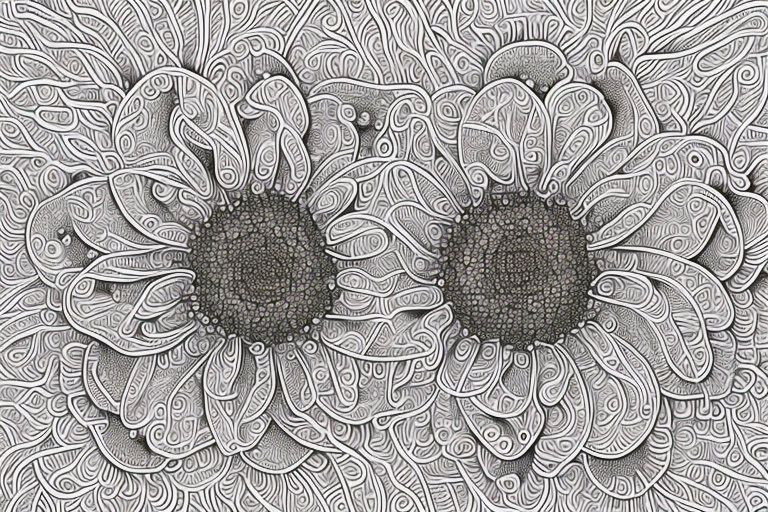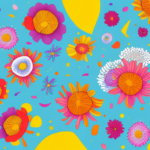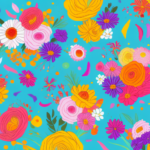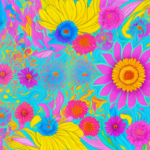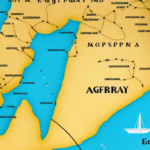Discovering the Beauty of Pollen Floral Art
Floral art is a timeless and beautiful way to incorporate natural elements into our homes. One type of floral art that is often overlooked is pollen floral art. Pollen floral arrangements are unique in that they showcase the beauty of pollen itself, rather than just the flowers alone. In this article, we will explore the history, techniques, and benefits of incorporating pollen floral art into our lives.
The Origins and Evolution of Pollen Floral Art
A Brief History
The use of pollen in floral arrangements can be traced back to ancient Egypt, where it was used to decorate temples and tombs. However, it was not until the 20th century that pollen floral art began to gain popularity as a form of contemporary art. Today, numerous artists specialize in this beautiful art form, creating stunning arrangements that celebrate the beauty of nature.
One reason for the rise in popularity of pollen floral art in the 20th century was the increased availability of different types of pollen. Advances in harvesting and preserving techniques allowed artists to experiment with a wider range of colors and textures, leading to more intricate and complex arrangements.
Modern Trends and Innovations
In recent years, there has been a growing interest in using pollen floral art to promote environmental awareness and conservation. Artists are leveraging their work to highlight the importance of preserving natural habitats and protecting endangered species. Additionally, sustainable practices have become more prominent, with the use of local and organic materials gaining traction.
Innovations in sustainable floral art include the incorporation of non-traditional materials such as succulents and air plants, creating a unique and contemporary look. The trend towards smaller, more delicate arrangements allows for versatile placement throughout the home, enhancing both aesthetic appeal and environmental consciousness.
Techniques for Creating Stunning Pollen Floral Arrangements
Gathering Materials
Creating a pollen floral arrangement is a delicate art that requires skill and patience. Begin by gathering a variety of flowers and pollen. Choose flowers with a range of colors and textures to add depth and interest to your arrangement. Experiment with different shapes and sizes to create a dynamic look.
Arrangement Tips
The key to a beautiful pollen floral arrangement is balancing the colors and shapes of the flowers and pollen. Incorporate other natural elements like leaves, branches, and berries to create a more organic appearance. Consider the size and shape of your container; a tall vase may require longer stems, while a wider container may need more flowers to fill it out. Playing with the height and placement of the flowers can add a dynamic and interesting dimension to your arrangement.
Seasonal considerations are also important. Use bright, bold colors for a summer party or more muted tones for a fall centerpiece. Incorporate seasonal elements like pinecones or holly for a festive touch.
Beginner's Tips and Tricks
- Choose flowers and pollen that are in season to ensure freshness and vibrancy.
- Experiment with different containers, such as vintage vases, mason jars, or even hollowed-out coconuts.
- Play with the scale of your arrangement to create either large, dramatic centerpieces or smaller, delicate displays.
- Select a color scheme that complements your space, using complementary or contrasting colors for desired effects.
- Properly care for your flowers by cutting stems at an angle, changing vase water regularly, and adding flower food.
The Best Flowers for Pollen Floral Art
Selecting the right flowers is crucial for creating impactful pollen floral arrangements. Some of the best flowers to use include:
- Sunflowers: Known for their large, prominent pollen clusters.
- Daisies: Offer a simple yet elegant look with ample pollen.
- Lilies: Provide rich textures and vibrant colors.
- Dahlias: Add intricate patterns and varied textures.
For a more unique touch, experiment with less common flowers like coneflowers, black-eyed Susans, and poppies. Additionally, consider the color of the pollen to enhance your arrangement's visual appeal. Monochromatic schemes can create harmony, while contrasting colors can make a bold statement.
Sources:
Britannica on Flower Arranging,
Gardening Know How on Pollen Production
Health and Wellness Benefits of Pollen Floral Art
Beyond their aesthetic appeal, pollen floral arrangements can enhance mental and physical well-being. Studies have shown that exposure to nature reduces stress, anxiety, and depression. By bringing natural elements like flowers and pollen into our homes, we can create a relaxing and inspiring environment that promotes wellness and mindfulness.
Furthermore, certain flowers and plants used in pollen floral art possess natural healing properties. For example, lavender promotes relaxation and improves sleep quality, while eucalyptus helps relieve congestion and respiratory issues.
Engaging in pollen floral art can also be a creative outlet, boosting mood and self-esteem. Experimenting with colors, textures, and arrangements fosters personal expression and provides a sense of accomplishment.
Sources:
NCBI on Nature and Mental Health,
Healthline on Lavender Benefits
Types of Pollen Floral Arrangements
Ikebana Style
Ikebana is a traditional Japanese style of floral arrangement that emphasizes simplicity, symmetry, and balance. This sparse, minimalist approach focuses on the natural beauty and structure of the flowers and pollen.
English Garden Style
The English Garden style features large, overflowing bouquets that evoke a romantic or whimsical feel. This style is characterized by a lush, abundant display of diverse flowers and foliage.
Modern Style
Modern pollen floral arrangements emphasize clean lines and geometric shapes. Often incorporating non-traditional materials such as succulents and air plants, this style offers a unique and contemporary aesthetic.
Wildflower Style
The Wildflower style adopts a natural and organic approach, showcasing a mix of different types of flowers and foliage arranged in a loose and unstructured manner. Ideal for rustic or bohemian-themed settings, this style celebrates the untamed beauty of nature.
Sources:
Ikebana Japan,
Flower Arranging Guide
The Role of Pollinators in Pollen Floral Art
Pollinators such as bees and butterflies are essential in the creation of pollen floral arrangements. They are responsible for pollinating flowers and producing the pollen used in these art forms. Incorporating flowers that attract pollinators not only enhances the beauty of your arrangement but also supports the vital roles these creatures play in our ecosystems.
By choosing pollinator-friendly flowers, you contribute to the preservation of these important species and promote biodiversity. Flowers like lavender, sunflowers, and marigolds are excellent choices for attracting a variety of pollinators.
Sources:
National Geographic on Pollinators,
American Beekeeping Federation
Sustainability in Pollen Floral Art
Using Local Wildflowers
Incorporating local wildflowers into your pollen floral arrangements is an excellent way to promote sustainability. Local flowers support native ecosystems and reduce the environmental impact associated with transporting flowers over long distances.
Experimenting with other natural materials such as twigs, bark, and moss can further enhance the sustainability of your arrangements. These elements add texture and an organic feel, perfect for creating eco-friendly and visually appealing designs.
Eco-Friendly Practices
- Choose sustainably sourced flowers to minimize environmental impact.
- Utilize biodegradable or reusable containers for your arrangements.
- Implement water-saving techniques and avoid excessive use of floral foam.
Sources:
EPA on Sustainable Floral Management,
National Geographic on Sustainable Floral Arrangements
Future Trends in Pollen Floral Art
Pollen floral art continues to evolve, embracing new trends and technological advancements. The future of pollen floral art includes:
- Digital Integration: Using digital tools and augmented reality to design and visualize arrangements.
- Hybrid Arrangements: Combining traditional floral techniques with modern materials and methods.
- Personalization: Customizing arrangements to reflect individual styles and preferences.
- Educational Integration: Incorporating botanical education into floral art to raise awareness about plant biology and ecology.
As sustainability and technological integration become more prominent, pollen floral art will continue to adapt, offering innovative and environmentally conscious designs.
Sources:
Fresh Orleans Flowers on Future Trends,
Boundless Floral Design Insights
Maintenance and Longevity of Pollen Floral Arrangements
Care Tips
- Change the water in your vase every few days to prevent bacterial growth.
- Trim the stems at an angle regularly to enhance water absorption.
- Remove any dead or wilted flowers and pollen to keep the arrangement fresh.
- Add flower food to the water to nourish your blooms and extend their lifespan.
Proper Storage
Store arrangements in a cool, shaded area away from direct sunlight and drafts. This helps maintain their vibrancy and prevents premature wilting.
Sources:
FTD on Floral Arrangement Care,
Gardeners.com on Caring for Floral Arrangements
The Symbolism and Meaning of Pollen Flowers
Flowers and pollen carry significant symbolism and meaning, often associated with various emotions and concepts. Understanding these can enhance the personalization and depth of your arrangements.
- Red: Love and passion.
- Yellow: Friendship and joy.
- White: Purity and innocence.
- Purple: Royalty and admiration.
Incorporating these symbolic colors thoughtfully can create arrangements that convey specific messages and moods, making them meaningful additions to any setting.
Sources:
FTD on Flower Symbolism,
Britannica on Flower Giving
The Intersection of Science and Art in Pollen Floral Designs
Pollen floral art exemplifies the intersection of science and art. Understanding the biology and function of flowers and pollen allows artists to create arrangements that are both beautiful and meaningful. This synergy fosters a deeper connection with nature and encourages the appreciation of botanical sciences.
By integrating scientific knowledge into artistic practices, pollen floral art can highlight the intricate processes of plant reproduction and the vital roles of pollinators. This approach not only enhances the aesthetic value of the arrangements but also educates and raises awareness about environmental and ecological issues.
Sources:
Science Daily on Plant Biology and Art,
Nature on Pollination Services















